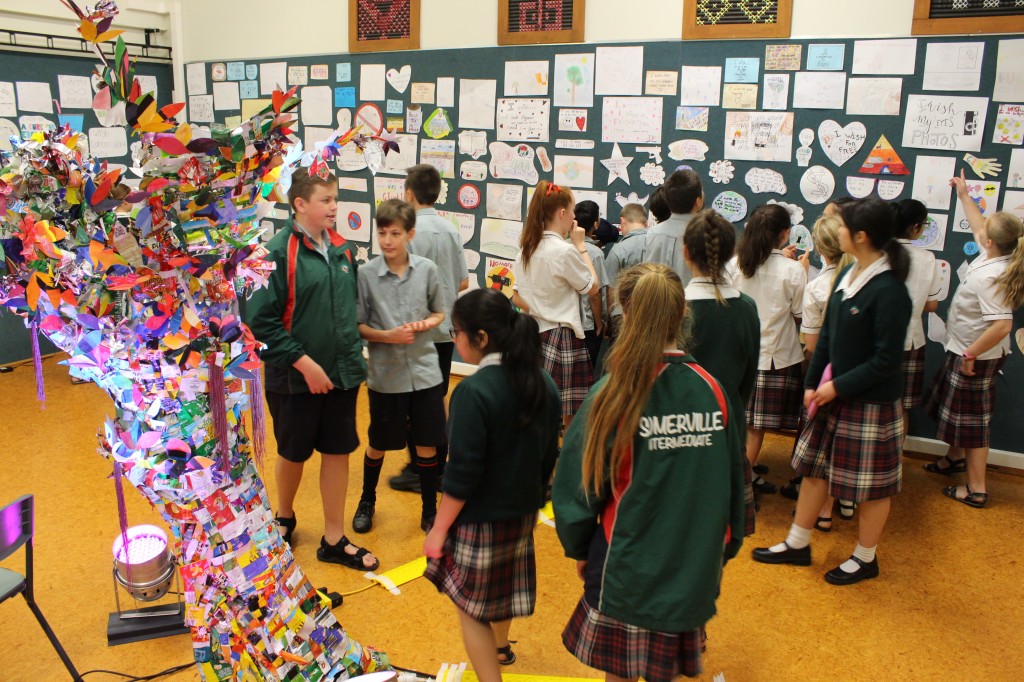Brazilian professor Paulo Teles had his wish fulfilled during October when he got the opportunity to bring his extraordinary arts and multimedia Wishing Tree project to New Zealand.
Dr Teles, who is with the Multimedia, Media and Social Communication Department in the Art Institute at the University of Campinas, Sao Paulo, had already taken his Interactive Sensorial Installation Art and Technology Workshop to schools in a variety of countries, including Brazil, Portugal, Germany and Greece, each time working with students aged 9 to 13. This time he was working with pupils at Auckland’s Somerville Intermediate School, which has a roll of 960 – the largest school he’s been involved with.
The week-long project involved the production of an installation referred to as “The Wishing Tree” – a multimedia interpretation of Japanese and Indian tales about a magical tree that has the power to fulfil the wishes that people attach to it. Organised by Somerville art teacher Ros Craw, a core group of 25 pupils started creatisng the pohutukawa wishing tree out of recycled materials: sliced-up snack wrappers and chip packets collected from fellow pupils over one and a half days. The strips were hot-glued onto an old sculpture that formed the basic frame, then they wired on long canes to create the branches. The “tree” was built from these strips and recycled artworks chosen by Ros and the pupils, with the help of Brazilian artist/sculptor Zay M Pereira, who was here to assist with the project. Multi-coloured leaves were cut out of the artworks and red-coloured wrappers were sliced up and hot-glued together to create the pohutukawa flowers.
Once the tree was finished, Zay attached three ultrasonic sensors at strategic points and covered the wires with more wrapper strips.
Then the pupils sat down to start expressing their wishes in texts and drawings. Eighteen students were chosen to have their wishes recorded by Paulo and Zay, and wishes were recorded in Russian, Maori, Cantonese, German and Mandarin as well as English. Meanwhile, Paulo set about animating some of the students’ drawings.
As news of the project spread through the school, many other pupils became interested and drawings of wishes started pouring in from most classes. Some children cried while creating their wishes during class time.
In all, 660 students and their teachers came to hear about the project and experience the Wishing Tree, interacting with the sensors that through their movements caused different images and animations to be projected onto a large white screen. Meanwhile, the recorded wishes played over the top of a soundtrack provided by the school’s music department. By the end of the project, more than 900 wishes had been stapled to the walls of the Wishing Tree room.
An evening viewing was also held and this attracted parents, friends and other students. Some pupils even came for a second or third viewing. Some of the wishes were so heartfelt that the teachers and children reading them were reduced to tears. No one who saw the tree and read the wishes could fail to have been moved by the depth of thought that had gone into the bulk of them. Although some wishes were more self-centred, most pupils had given serious consideration to problems in their family, their school and community, their country or in the wider world. The project opened their minds to the world around them and made them realise that not all their classmates had the same untroubled lives as they did.
It is Paulo’s hope that at some point in the future he will be able to collect the Wishing Trees from the various countries in one place, along with the teachers, and create a Wishing Forest.
Many thanks to the Bobby Stafford-Bush Foundation for providing funds to help this project get off the ground.
Alison Mudford
NZ co-ordinator



